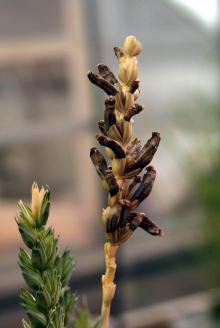Cause The fungus, Claviceps purpurea, attacks barley, oats, rye, triticale, and numerous wild grasses as well as wheat. The hard black sclerotia of the fungus germinate to produce stromata, which form ascospores carried by wind or insects to the flowering cereal. A conidial stage, called honeydew, forms on the infected head; insects can transmit the honeydew to uninfected flowers. Sclerotia formed on the heads drop to the ground or are mixed with seed for the next year. Infections frequently spread from wild grasses into cultivated cereals. Losses can be severe if livestock eat sclerotia in grain. Ergot is favored by wet, cool weather.
Symptoms The most conspicuous symptom is hard, pointed, black to deep-purple sclerotia that replace one or more kernels in the head. Sclerotia are several times longer than kernels and are easily seen on the head or mixed with grain. After flowering but before heading, a sticky conidial stage, or honeydew, can be seen on infected heads.
Cultural control
- Rotate cereals with a nongrass crop to significantly reduce inoculum in 1 year.
- Do not plant seed that contains sclerotia.
- If seed containing sclerotia must be used, plant seed at least 2 inches deep.
- Mow native grasses before they flower.
- When ergot is prevalent in native grass on the field's margins, harvest the outside of the field separately.
- Cleaning removes most sclerotia from harvest grain.
- Destroy screenings by burning. Do not feed to livestock.
- Use tillage practices that bury sclerotia at least 1.5 inches below the soil surface.

